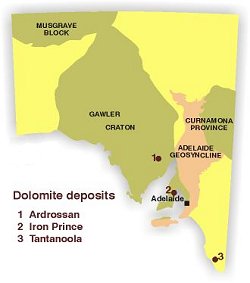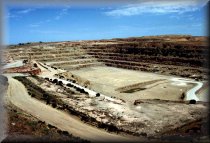 Dolomite has significance as an industrial mineral in number of industries. In the steelmaking industry it is used as a flux and for manufacture of refractories for basic open earth furnaces. Bessemer converters and steel ladles; in cement manufacture of refractories which line rotary cement kilns. It is used in manufacturing glass and fibre glass as a fertilizer and a stockfeed supplement; also it is important as a crushed construction material.
Dolomite has significance as an industrial mineral in number of industries. In the steelmaking industry it is used as a flux and for manufacture of refractories for basic open earth furnaces. Bessemer converters and steel ladles; in cement manufacture of refractories which line rotary cement kilns. It is used in manufacturing glass and fibre glass as a fertilizer and a stockfeed supplement; also it is important as a crushed construction material.
The mineral dolomite has a theoretical composition of CaCO3.MgC03 however, because dolomite deposits are usually formed by the solution replacement of up to 50% of the calcium in limestones with magnesium, the actual composition of the rock within the broader deposit may vary in grade from almost pure limestone to (with increasing magnesium) dolmite. The "grade" of the rock will influence the industrial end use to which the dolomite may be used.
South Australian has an annual production of approximatley 0.3 Mt of industrial and agricultural dolomite. Hardrock dolomite quarries operating largely for production of dolomite for the construction industry may also produce industrial dolomite as a by-product.
Palaeoproterozoic
Beds of dolomitic marble of the Katunga Dolomite occur within metasediments of the Palaeoproterozoic Hutchison Group on eastern Eyre Peninsula. These are generally too low grade to be suitable for industrial uses. At the Iron Prince mine however, where the Katunga Dolomite has been exposed beneath the Lower Middleback Jaspilite, the principal impurity is iron which may comprise up to 30% of the rock.
OneSteel finds this a convenient local source of flux for pelleted iron ore at Whyalla and mines approximately 90 000 t/year. It has been mined a campaign basis in the past to a maximum of ~ 90 000 t/year.
Cambrian
|
|
The largest dolomite mining operation in Australia is at Ardrossan on northern Yorke Peninsula, where Arrium Mining Ltd operates a quarry, crushing plant and ship-loading facility. Full production was commenced by BHP in 1950, with production in 2013 in the order of 400,000 tonne. The dolomite is fine grained, dense, and yellow to brown in colour. Lump ore is used mainly as a flux in basic oxygen steelmaking at Whyalla, Port Kembla and Newcastle. It is also used as a refractory material at the Whyalla Steelworks. About a quarter of production is exported to Japan.
The quarry is located in a shallow southerly plunging syncline in which the dolomitic Kulpara Formation of the Early Cambrian Hawker Group exceeds 300 m in thickness. This formation crops out at intervals between Ardrossan and Kulpara, and includes thick sequences of high-grade dolomite. Remaining resources of material similar to that being mined are enormous.
Cambrian carbonate rocks are widespread in the Flinders Ranges and on the Stuart Shelf, and have been dolomitised in many localities. Sampling of the Ajax Limestone along the western flank of the Flinders Ranges has shown the lower part of the formation to be dolomitic, with MgCO3 content of 41.9%. A dolomite section of Andamooka Limestone exposed in Axehead Quarry near Roxby Downs and developed for supply of construction material contains 41.1% MgCO3.
Tertiary
In the Lower South-East, dolomite has been formed by metasomatic replacement of bryozoal limestone in close proximity to faults. The dolomite is usually pink and of variable hardness and texture. Dolomitisation is irregular and unpredictable, and dolomite passes vertically and laterally into white, highly calcareous bryozoal limestone of the Oligo-Miocene Gambier Limestone.
Sibelco Australia Ltd now operates the former ACI quarry in an irregularly dolomitised zone adjacent to the Tartwaup Fault, 5 km east-southeast of Tantanoola. The quarry was originally opened to supply rail ballast and other construction materials, but the dolomite has been used for glassmaking flux since 1961. Quarried rock is screened, crushed and blended to give a -3 mm product with an average grade of 42% MgCO3. About 32 000 t/year are trucked plants for use as flux in the manufacture of plate glass. Agricultural dolomite is produced as a by-product.
Dolomite similar in type and composition occurs between Burnda and Compton near Mount Gambier, and a number of irregular lenses arranged en echelon within Gambier Limestone mark the trace of the Nelson Fault over a distance of 2 km in the hundred of Caroline, 30 km southeast of Mount Gambier.
Flat lying Pliocene to Pleistocene lacustrine dolomite that occurs as plateaux marginal to southern lake Eyre were investigated in the 1970s. Larger resources >750 Mtonne were estimated at grade 19% MgCO3 at Alberie Creek, Babbage Peninsula, and Umbum Creek.
Additional Reading
Johns, R.K., 1963. Limestone, dolomite and magnesite resources of South Australia. South Australia. Geological Survey. Bulletin, 38.
Valentine, J.T., 1989. Industrial and non metallic minerals — operations in South Australia. South Australia. Department of Mines and Energy. Report Book, 89/74:42-48.



